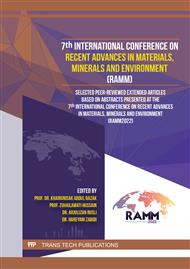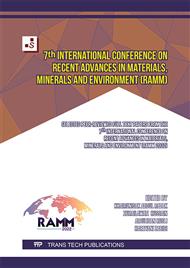[1]
F.I. Ismail, S.A. Farhan, N. Shafiq, N. Husna, M.T. Sharif, S.U. Affan, A.K. Veerasenan, Nano-porous silica-aerogel-incorporated composite materials for thermal-energy-efficient pitched roof in the tropical region, Appl. Sci. 11 (2021) 6081.
DOI: 10.3390/app11136081
Google Scholar
[2]
M.F. Khamidi, C. Glover, S.A. Farhan, N. Husna, M.F. Nuruddin, Effect of silica aerogel on the thermal conductivity of cement paste for the construction of concrete buildings in sustainable cities, in: W.P. De Wilde, S. Hernández, C.A. Brebbia (Eds.), High Performance and Optimum Design of Structures and Materials, WIT Press, Southampton, UK, 2014, p.665–674.
DOI: 10.2495/hpsm140601
Google Scholar
[3]
N.N. Zulkarnain, S.A. Farhan, Y.A. Sazali, N. Shafiq, S.H. Abd Rahman, A.I. Abd Hamid, M.F. Habarudin, Reducing the waiting-on-cement time of geopolymer well cement using calcium chloride (CaCl2) as the accelerator: Analysis of the compressive strength and acoustic impedance for well logging, Sustainability 13 (2021) 6128.
DOI: 10.3390/su13116128
Google Scholar
[4]
F.I. Ismail, S.A Farhan, N. Husna, N. Shafiq, M.M. Abdul Wahab, S.N. Abd Razak, Influence of graphene nanoplatelets on the compressive and split tensile strengths of geopolymer concrete, IOP Conf. Ser. Earth Environ. Sci. 945 (2021) 012060.
DOI: 10.1088/1755-1315/945/1/012060
Google Scholar
[5]
S.N. Abd Razak, N. Shafiq, L. Guillaumat, M.M. Abdul Wahab, S.A Farhan, N. Husna, F.I. Ismail, Fire performance of fly ash-based geopolymer concrete: Effect of burning temperature, IOP Conf. Ser. Earth Environ. Sci. 945 (2021) 012062.
DOI: 10.1088/1755-1315/945/1/012062
Google Scholar
[6]
S.H. Abd Rahman, S.A. Farhan, Y.A. Sazali, L.H. Shafiee, N. Husna, A.I. Abd Hamid, N. Shafiq, N.N. Zulkarnain, M.F. Habarudin, Effect of elastomeric expandable additive on compressive strength and linear expansion of fly-ash-based strength-enhanced geopolymer cement for shrinkage-resistant oil-well cementing, Appl. Sci. 12 (2022) 1897.
DOI: 10.3390/app12041897
Google Scholar
[7]
N.K. Krishna, M. Prasanth, R. Gowtham, S. Karthic, K.M. Mini, Enhancement of properties of concrete using natural fibers, Mater. Today: Proc. 5 (2018) 23816–23823.
DOI: 10.1016/j.matpr.2018.10.173
Google Scholar
[8]
M. Ali, A. Liu, H. Sou, N. Chouw, Mechanical and dynamic properties of coconut fibre reinforced concrete, Constr. Build. Mater. 30 (2012) 814–825.
DOI: 10.1016/j.conbuildmat.2011.12.068
Google Scholar
[9]
Y. Ding, Y. Zhang, A. Thomas, The investigation on strength and flexural toughness of fibre cocktail reinforced self-compacting high performance concrete, Constr. Build. Mater. 23 (2009) 448–452.
DOI: 10.1016/j.conbuildmat.2007.11.006
Google Scholar
[10]
N. Kabay, Abrasion resistance and fracture energy of concretes with basalt fiber, Constr. Build. Mater. 50 (2014) 95–101.
DOI: 10.1016/j.conbuildmat.2013.09.040
Google Scholar
[11]
M. Nili, V. Afroughsabet, The effects of silica fume and polypropylene fibers on the impact resistance and mechanical properties of concrete, Constr. Build. Mater. 24 (2010) 927–933.
DOI: 10.1016/j.conbuildmat.2009.11.025
Google Scholar
[12]
R. Ahmad, R. Hamid, S. A. Osman, Physical and chemical modifications of plant fibres for reinforcement in cementitious composites, Adv. Civ. Eng. 2019 (2019) 5185806.
DOI: 10.1155/2019/5185806
Google Scholar
[13]
S.S. Munawar, K. Umemura, S. Kawai, Characterization of the morphological, physical, and mechanical properties of seven nonwood plant fiber bundles, J. Wood. Sci. 53 (2007) 108–113.
DOI: 10.1007/s10086-006-0836-x
Google Scholar
[14]
H. Syed, R. Nerella, S.R.C. Madduru, Role of coconut coir fiber in concrete, Mater. Today: Proc. 27 (2020) 1104–1110.
DOI: 10.1016/j.matpr.2020.01.477
Google Scholar
[15]
ASTM C172: Standard Practice for Sampling Freshly Mixed Concrete, ASTM International, PA, USA, 2017.
Google Scholar
[16]
ASTM C192: Standard Practice for Making and Curing Concrete Test Specimens in the Laboratory, ASTM International, PA, USA, 2019.
Google Scholar
[17]
ASTM C109: Standard Test Method for Compressive Strength of Hydraulic Cement Mortars (Using 2-in. or [50-mm] Cube Specimens), ASTM International, PA, USA, 2021.
DOI: 10.1520/c0109_c0109m-99
Google Scholar
[18]
ASTM C496: Standard Test Method for Splitting Tensile Strength of Cylindrical Concrete Specimens, ASTM International, PA, USA, 2017.
Google Scholar
[19]
B. Ramesh, S. Eswari, Mechanical behaviour of basalt fibre reinforced concrete: An experimental study, Mater. Today: Proc. 43 (2021) 2317–2322.
DOI: 10.1016/j.matpr.2021.01.071
Google Scholar



